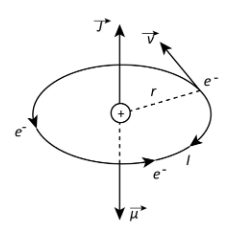
The angular momentum of an electron is $J$. Its magnetic moment will be
A. $\dfrac{{mJ}}{{2e}}$
B. $\dfrac{{eJ}}{{2m}}$
C. $\dfrac{{2m}}{{ej}}$
D. $\dfrac{{emJ}}{2}$
Answer
559.2k+ views
Hint:We know that according to the Bohr model of hydrogen like atom, electron (negative charge) revolves around the nucleus (positive charge). The uniform circular motion of the electron around the nucleus is equivalent to the current loop which has a magnetic dipole moment $\left( {\mu = IA} \right)$ and angular momentum is the product of linear momentum and perpendicular distance.
Complete step by step answer:
From the question, we know that the angular momentum is $J$ and we have developed the expression of the magnetic moment in terms of $J$. Now let us consider an electron revolving counter clockwise a nucleus in an orbit of radius $r$ with speed $v$ and time period $T$.

The above figure represents the orbital magnetic moment of a revolving electron.
The expression of the current in the loop,
$
I = \dfrac{q}{T}\\
\Rightarrow I = \dfrac{e}{T}\\
$
The area of the loop in which current is revolving is,
$A = \pi {r^2}$
The time period of the electron can be expressed as,
$
T = \dfrac{{2\pi }}{\omega }\\
\Rightarrow T = \dfrac{{2\pi r}}{v}\\
$
Here, $\omega $ is the angular velocity of the electron.
We know that the orbital magnetic moment or the magnetic moment due to orbital motion of the electron motion of the electron is expressed as,
$\mu = IA$
Substitute the expression in the above equation.
$\mu = \dfrac{e}{{\left( {\dfrac{{2\pi r}}{v}} \right)}} \times \pi {r^2}$
$\Rightarrow\mu = \dfrac{{evr}}{2}$ ... (I)
Also, the angular momentum of the electron due to its orbital motion,
$J = mvr$ ... (II)
Here, $m$ is the mass of the electron.
From equation (I) and (2), we get,
$
\dfrac{\mu }{J} = \dfrac{{\left( {\dfrac{{evr}}{2}} \right)}}{{mvr}}\\
\therefore \mu = \dfrac{{eJ}}{{2m}}\\
$
Thus, option (B) is correct.
Note:As the electron (negative charge) is revolving counter clockwise, the direction of the current associated to it is clockwise. From the right hand thumb rule, the direction of the magnetic moment of the electron will be perpendicular to the plane of its orbit.
Complete step by step answer:
From the question, we know that the angular momentum is $J$ and we have developed the expression of the magnetic moment in terms of $J$. Now let us consider an electron revolving counter clockwise a nucleus in an orbit of radius $r$ with speed $v$ and time period $T$.

The above figure represents the orbital magnetic moment of a revolving electron.
The expression of the current in the loop,
$
I = \dfrac{q}{T}\\
\Rightarrow I = \dfrac{e}{T}\\
$
The area of the loop in which current is revolving is,
$A = \pi {r^2}$
The time period of the electron can be expressed as,
$
T = \dfrac{{2\pi }}{\omega }\\
\Rightarrow T = \dfrac{{2\pi r}}{v}\\
$
Here, $\omega $ is the angular velocity of the electron.
We know that the orbital magnetic moment or the magnetic moment due to orbital motion of the electron motion of the electron is expressed as,
$\mu = IA$
Substitute the expression in the above equation.
$\mu = \dfrac{e}{{\left( {\dfrac{{2\pi r}}{v}} \right)}} \times \pi {r^2}$
$\Rightarrow\mu = \dfrac{{evr}}{2}$ ... (I)
Also, the angular momentum of the electron due to its orbital motion,
$J = mvr$ ... (II)
Here, $m$ is the mass of the electron.
From equation (I) and (2), we get,
$
\dfrac{\mu }{J} = \dfrac{{\left( {\dfrac{{evr}}{2}} \right)}}{{mvr}}\\
\therefore \mu = \dfrac{{eJ}}{{2m}}\\
$
Thus, option (B) is correct.
Note:As the electron (negative charge) is revolving counter clockwise, the direction of the current associated to it is clockwise. From the right hand thumb rule, the direction of the magnetic moment of the electron will be perpendicular to the plane of its orbit.
Recently Updated Pages
A man running at a speed 5 ms is viewed in the side class 12 physics CBSE

The number of solutions in x in 02pi for which sqrt class 12 maths CBSE

State and explain Hardy Weinbergs Principle class 12 biology CBSE

Write any two methods of preparation of phenol Give class 12 chemistry CBSE

Which of the following statements is wrong a Amnion class 12 biology CBSE

Differentiate between action potential and resting class 12 biology CBSE

Trending doubts
What are the major means of transport Explain each class 12 social science CBSE

Which are the Top 10 Largest Countries of the World?

Draw a labelled sketch of the human eye class 12 physics CBSE

How much time does it take to bleed after eating p class 12 biology CBSE

Explain sex determination in humans with line diag class 12 biology CBSE

When was the first election held in India a 194748 class 12 sst CBSE




